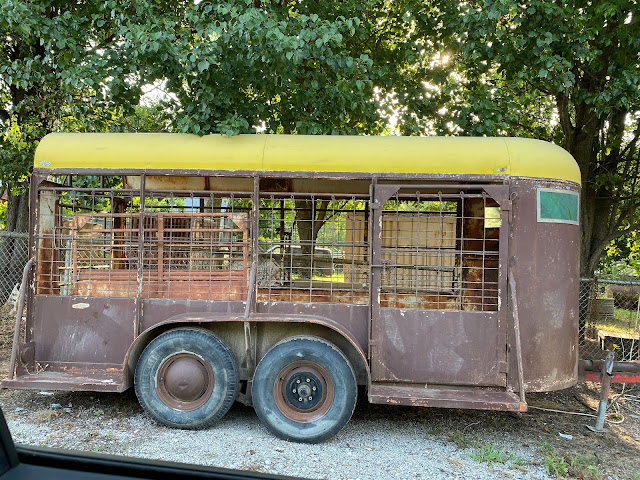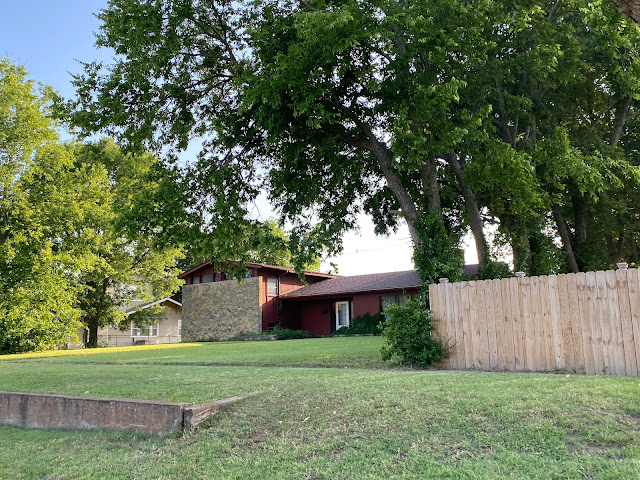“Fairfax will become a destination for thousands who want to know more about what happened here in the 1920s...”
There is this strange phenomena that occurs when you go searching for history. Especially now that we have the internet. You could (and do) spend way too much time chasing down information. And so true to what I had learned early on about the dangers of this endeavor= always consider your source, the date of the publication, and who wrote the publication. The schisms between the indigenous and white settlers are both deep-seated and often resulted in terrible and tragic events.
This internet archive gem was written in 1906 by Philip Dickerson. Hmmm, I first wonder, "who is this dude and why did he get to write and publish a 156 page history of an group of people with a long history on the land that became the United States?" The second thing, remembering that Oklahoma didn't become a state until 1907 was thrown up there to float around into my brain.
I got angry and lost just at the introduction, which is likely a love letter/bragging letter written by the author himself- attesting to his long credentialed list, affirming the justification that he, a white dude from "Old Dominion" Virginia, was going to be writing "literary, historical, and true as any other history."
"The writer's purpose is to give in a literary brief, in plain style, the true facts of the resources and opportunities of the Osage."
By page 3 and with paragraphs like this:
"The Osage never had a written language, completed. A priest of Neosho, Kansas, once wrote a dictionary of the language, but died before it was printed and somehow got destroyed before publication. Elex Tall Chief a highly educated young Osage, of the Tall Chief family near Fairfax, is said 'to be now compiling an Osage dictionary, but the writer has not yet gotten any part of it, nor met this lexicographer. Nor does he consider it of sufficient importance to publish one now, as it will be only a generation till all Osages will know English, the universal language of the future. There is such a thing as dialectic economy of time and energy in educating the world as in other things."
It is incredible what this man wrote! I almost tore my hair out reading the bullshit. That this account was published (and continues in print, purchasable on Amazon, despite being in the public domain for free) blows my mind.
Here is another little treat from Mr. Dickerson:
"The preceding cut shows some of the beauties of the building and improved grounds, with the happy little Osage girls, mostly under 16 years of age, and the Sisters who teach them all the arts of domestic life and literature and music, for which they have the very best facilities for studying under the kind and efficient instruction of the Sisters."
Some of the information, tainted and skewed by the biographer, is still interesting. I often wonder about "transitional times" in our country's history. Change is often subtle and unrealizable except from a longer range view. Like home construction. Here Peterson gives an example:
"Saucy Chief was the first chief to come to an Indian Agent, Laban J. Miles at that time, and declared that he wanted to walk in the way of the white man and desired to have a house built for him. Such was the general antagonism to his action, that his band split up, and one faction elected a chief over them during the '70's. But when they did become reconciled to have houses nearly all wanted the best house, best land, best horses instead of mules. They never used oxen. They manifest much pride in having the best of everything. But the houses were generally rented to the whites while they live in their tents or wigwams."
Another area of interest covered by Peterson is almost comical in its bullshit rhetoric, especially in light of all that we have learned about the white-run institutional boarding schools in the U.S. as well as Canada:
"For more than a half century they have had all the modern privileges of a literary education. They have had schools in their midst for many decades and all who have desired to go, have been sent to Carlisle, Penn., or Lawrence, Kan., to graduate, or to other institutions equally famous."
Is it time to say, "enuf said?" Readers getting the point? Really it is about mindsets and background knowledge. Did I know enough to be traipsing around in these places that were so foreign to me? My heart kind of said, "no." My curious mind said, "yes."
So let's get out of Philip Dickerson's narrative, and back to more neutral history. Let's see if I can summarize a bit:
Pawhuska became a central space for both Osage Nation folks as well as settlers, sooners, or whatever they were called. Alliances began to form and 2-way beneficial relationships as well, be it business or pleasure. I already wrote about and shared my pictures from this place/space.
A good history can be found here:
On the outskirts of this area, other outposts existed- pockets of/groups of Osage who lived according to their native and cultural ways. Again white men were able to assimilate into these communities to set up trading posts.
By the late 1800's/early 1900's, a white man, Lew Wismeyer, had leased from the Osage a small plot, started a townsite, and convinced the RR to build a stop in this town. That would be Fairfax. By 1907 there were almost 500 folks there along with stores, farms, ranches, and oil. And many wealthy Osage folks who leased the land and also had head rights and allotments from the oil pulled from the land.
Things changed in the boom days. Capitalism changed many things for many people, as it did all over the country. This little corner of the vast United States became nationally known for the period of time between circa 1910-1930.
A good oral + digital history can be found here:
Back In Time: Osage Murders - Reign of Terror
More recent, filming location videos:
film locations for Osage Murders movie
Pre-film video Killers of Flower Moon
Salt Creek is a remote wilderness stream that runs for approximately 50 miles. It is natural and untouched by signs of civilization. Very peaceful space.
The 1st Street Bridge. No longer operational. Built in 1916, it is an example of a Warren truss bridge and used to be the Rt. 18 into town (1920's=newly established state highway 18). A more modern replacement is nearby. The street continues on into town, parallel with the Main St. There are houses further on, mostly built in the 1920's + 30's. They now sell for 20K-less than 10K.
My husband espied this funky sight. Once upon a time, an advertisement on the new Highway 18, now grown into the tree. I wonder what it was advertising.
The telltale sign of depressed towns as we travel= a lone Dollar General around some rundown properties.
I snapped this one because I had not seen anything like it. Incorporated in 1939, it is a member-owned not-for-profit that provides electric service to members in 7 north-central OK communities. I like it!
Somewhere on the ride into downtown is this fence post with the TallChief sisters on it.
Back in the day.
Old First National Bank and Masonic Lodge Building
This small town looks worn down. Hard to image it being car-clogged in the 1920's when the boom was happening.
Across the street in the 100 block of Elm St. is the City Hall/Police Department. Built 1920
Oddly compelling artwork on a building. I sure wonder what the story is about/behind this painting.
One block beyond the main street. We were searching for the Lincoln Colored School on Northeast Walnut St.
And we found it! Sad shape for a National Historic Site. From the register:

FURTHER ALONG THE OLD HIGHWAY ROUTE (1ST ST.):
I fell in love with this building. It is on the corner of 1st and Mulberry St. and is indeed a WPA Project building! The town garage.Constructed of untooled and randomly laid native sandstone, the County Warehouse is rectangular (101′ x 43′) with a stepped gable roof. A one-half moon vent is in each gable. Two garage doors on either side of the building directly across from each other permit vehicles to drive completely through. Window at the ends of the structure, either full or one half size, have sills, lintels and jambs of pre-formed concrete. Door and garage lintels are of the same materials as are the caps of the stepped gable. Windows are metal casements.
Architecturally the structure is significant in the community in terms of type, style and workmanship. As a WPA building it is notable in that county warehouse facilities are relatively rare, especially ones with stepped gables and pre-formed concrete window jambs. Construction of the building also provided job opportunities for unemployed day laborers and oil field workers who had been pushed into economic destitutuion by the national depression.
There it is- the official WPA plaque. I wonder who Earl Gray was? Yeah, I thought that too (is it related to the English tea somehow???) The E.G. here was born in 1888/9 + is buried up in the Fairfax Cemetery.
North 1st St.
N. 2nd St. circa 1940
East Locust + North 2nd St. (see description of house below)
North 2nd St. Proud owner.











































































No comments:
Post a Comment